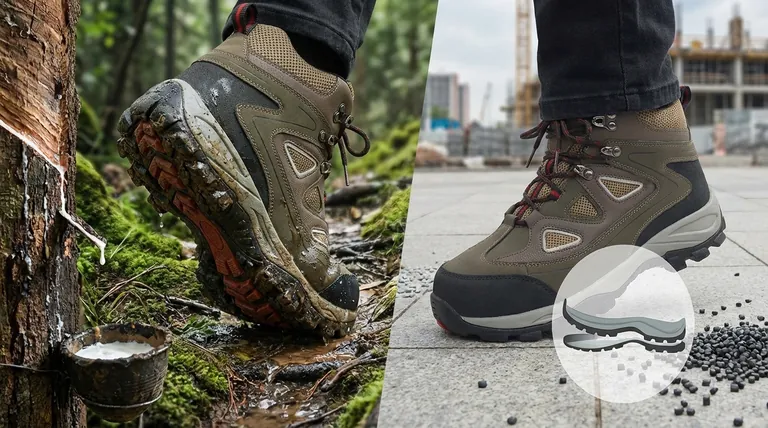In a direct comparison, natural rubber soles offer superior flexibility compared to TPR (Thermoplastic Rubber) soles. While TPR is certainly a flexible material, it does not match the elastic, pliable nature of rubber, which allows for a more complete and natural range of foot motion.
The choice between rubber and TPR is a fundamental trade-off between premium performance and cost-effective practicality. Rubber delivers superior flexibility, grip, and durability, while TPR provides a lightweight, water-resistant, and more affordable alternative.

A Head-to-Head Comparison: Rubber vs. TPR
Understanding the core differences between these two common sole materials is key to selecting footwear that aligns with its intended use. Each material has a distinct profile of strengths and weaknesses.
The Critical Factor: Flexibility and Comfort
Natural rubber is known for its exceptional elasticity. This allows the sole to bend and move seamlessly with your foot, enhancing comfort and reducing fatigue, especially during activities that require significant movement.
TPR is a synthetic blend that mimics rubber but has less "give." While it provides adequate flexibility for casual walking and daily wear, it can feel stiffer than natural rubber.
Grip and Traction Under Pressure
Rubber soles provide a superior grip, particularly on wet or slippery surfaces. The material's inherent tackiness and ability to conform to micro-surfaces create excellent traction and stability.
TPR soles are water-resistant, meaning the material itself does not absorb water. However, their grip in wet conditions is generally not as reliable as that of high-quality rubber.
Durability and Longevity
When it comes to wear and tear, rubber is the more durable material. Its high resistance to abrasion means it can withstand rough surfaces and heavy use over a longer period, making it ideal for premium, long-lasting footwear.
TPR soles are less durable in comparison. They are more susceptible to wearing down over time, which is a key reason they are often found on more affordable, casual shoes.
Understanding the Trade-offs
The decision to use rubber or TPR extends beyond pure performance metrics. Critical factors like cost and weight often drive the final choice for both manufacturers and consumers.
The Cost and Weight Equation
TPR is significantly more cost-effective to produce than natural rubber. This makes it the go-to choice for budget-friendly and mass-market footwear where keeping the final price low is a priority.
Furthermore, TPR is a lighter material than rubber. This can contribute to a lighter overall shoe, which may be a desirable feature for certain types of casual or fashion-oriented footwear.
The Environmental Angle
Natural rubber is a renewable resource harvested from trees, making it a more eco-friendly and sustainable option.
TPR, as a thermoplastic, is a synthetic material derived from petrochemicals. While it is often recyclable, its production process is not as environmentally friendly as that of natural rubber.
Making the Right Choice for Your Footwear
Your ideal sole material depends entirely on your priorities for the shoe.
- If your primary focus is maximum performance and durability: Choose rubber for its superior flexibility, grip, and long-term resilience, especially for outdoor or high-activity use.
- If your primary focus is a lightweight, affordable shoe for casual wear: TPR offers good value with adequate comfort and performance for everyday situations.
- If your primary focus is a premium feel and sustainability: Natural rubber provides a higher-quality experience and is the more environmentally conscious choice.
By understanding these core differences, you can confidently select footwear with a sole that is perfectly engineered for its purpose.
Summary Table:
| Feature | Rubber Soles | TPR Soles |
|---|---|---|
| Flexibility | Superior, elastic, natural foot motion | Adequate, can feel stiffer |
| Grip/Traction | Excellent, especially on wet surfaces | Good, but less reliable than rubber |
| Durability | High resistance to abrasion, long-lasting | Less durable, wears down faster |
| Weight | Heavier | Lighter |
| Cost | Higher | More affordable, cost-effective |
| Sustainability | Renewable, eco-friendly (natural rubber) | Synthetic, derived from petrochemicals |
Need the perfect sole for your footwear line?
As a large-scale manufacturer, 3515 produces a comprehensive range of footwear for distributors, brand owners, and bulk clients. Whether you require the superior performance of natural rubber or the cost-effective practicality of TPR, our production capabilities encompass all types of shoes and boots. We can help you select the ideal material to meet your specific needs for performance, budget, and target market.
Contact our experts today to discuss your sole material requirements and get a quote!
Visual Guide

Related Products
- Safety Footwear Wholesale Manufacturer for Custom OEM/ODM Production
- Custom OEM Training Shoes Wholesale Manufacturer Durable & Breathable
- Premium Safety Shoes with Rotating Buckle Safety Sneakers
- Durable Waterproof Rain Boots | Custom Manufacturer for Wholesale & Brands
- Durable Moc-Toe Wedge Work Boots | Wholesale Manufacturing for Brands
People Also Ask
- How do safety shoes contribute to cost savings for companies? A Strategic Investment in Risk and Cost Management
- What cultural and environmental considerations are tied to wearing shoes indoors? Balance Hygiene, Tradition, and Foot Health
- What do heavy duty boots do? Protect Your Feet in Demanding Work Environments
- Is it normal to wear shoes in the house? A Guide to Hygiene, Comfort & Culture
- How long can you wear safety boots? The Lifespan is Determined by Wear, Not Time



















